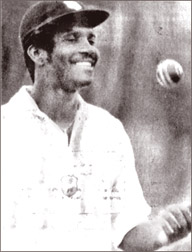Lawrence Rowe - the Windies great batsman
By A.C. De Silva
|

Lawrence Rowe of West Indies - 2 centuries in opening Test.
|
CRICKET: To score a century in one's first Test is a great
achievement. But when a player scores a century in both innings of his
first ever Test match, it is no doubt a time for celebration. And so it
was for West Indian player Lawrence Rowe in his first ever Test against
New Zealand on his home ground at Sabina Park, Kingston in February
1972.
Rowe, was 23 years of age then. A right-handed aggressive batsman, he
scored 214 runs and followed it up with 100 not out. His aggregate of
314 runs in his first Test paved the way for an illustrious way ahead
for him in his Test cricket career.
Born on January 8th 1949, Lawrence George Rowe was a star batsman in
the West Indies line-up. There was not a single stroke that he could not
execute. He rarely lifted the red cherry off the grass, a sign of a
truly great batsman.
It was difficult to set a field for him when the mood seized him; he
would look impregnable when in his element.
There was one other batsman to exceed 300 on debut and he was R.E.
"Tip' Foster who scored 287 and 19 for England against Australia at
Sydney in December 1903.
To score boundaries is any batsman's dream in Test cricket. The more
boundaries a batsman scores, the more confidence he becomes in his
batting. The most boundaries in an individual Test innings - and the
only instance of over 50 being struck - 57 by John Edrich during his
score of 310 not out for England against New Zealand at Headingley,
Leeds on July 8 and 9 in 1965.
Edrich hit 5 sixes and 52 fours during an innings lasting 532
minutes.
It remains England's only triple century since 1938 and the highest
first-class score by an Englishman at Headingley.
Patil 24 runs in one over
To score as many boundaries in an over will, no doubt, be the
expectation of the attacking batsman. In India there was a batsman by
the name of Sandeep Patil, who in the second Test against England at
Manchester on June 27 in 1982 got to the landmark.
Facing the bowling of Bob Willis - England's captain, Patil began the
over with 3 successive fours, the third delivery being a no-ball. He
failed to score off the next ball - a yorker, but hit fours off each of
the last three balls.
Patil thus equalled the Test record for the most runs by one batsman
off an over (24) set by Andy Roberts for the West Indies at
Port-of-Spain, Trinidad, on February 15th 1981.
Roberts, the first Antiguan to represent West Indies, struck
4,6,2,6,6 off the bowling of another England captain - Ian Botham,
before taking a leg-bye off the last ball.
Botham subsequently exacted his revenge by equalling this record
during his innings of 59 not out for England against New Zealand at the
Oval on 25th August 1986. He savaged the medium-fast bowling of Derek
Stirling for 4,6,4,6,0,4.
Jaisimha's slow batting
All elegant batsmen try to score as many runs as possible on a dry
day with the wicket helping the batsman to pile on the runs. However,
there was a time in the 1960s when India and Pakistan were involved in
hot battles. There was a period of play when run-making became somewhat
difficult. On an uninterrupted day of Test cricket, M. L. Jaisimha made
49 on December 18 in 1960.
Playing for India against Pakistan at Green Park, Kanpur, the
Hyderabad all-rounder took his score from 5 to 54 in 330 minutes. After
batting for 8 hours 20 minutes and spending nearly an hour in the
nineties, he attempted to run a single from a push back to the bowler
and was run out for 99.
In the game of cricket there are many records. To be not out and pile
on the runs will be any batsman's wish. Well, the record for being not
out most times in a test career is held, perhaps not surprisingly, by a
late-order-batsman-Bob Willis.
Willis not out 55 times
In 128 innings between January 1971 and July 1984, the England fast
bowler Willis was not out 55 times.
Equally predictably, another tail-ender Bhagwat Chandrasekhar claimed
the most pair of 'ducks' in Test cricket. The Indian spin bowler was
dismissed twice in a match without scoring on 4 occasions by New Zealand
at Wellington in February 1976, then by England for the same number of
times in Delhi 1976 and by Australia at Brisbane and Melbourne in the
1977-78 rubber.
Fielding records
In cricket, their is a saying that catches win matches. It is quite
pleasing to the eye when a fielder takes a good catch to dismiss a
batsman. The most catches taken by a none-wicket-keeper in a Test career
is 122 Greg Chappell in 87 matches for Australia between December 1970
and January 1984.
Chappell gained the record in his final Test against Pakistan at
Sydney again on 5th January 1984, when he held his 121st catch (Mohsin
Khan at second slip) to overtake the total which Colin Cowdrey had
achieved in 114 matches for England between 1954 and 1975.
|

